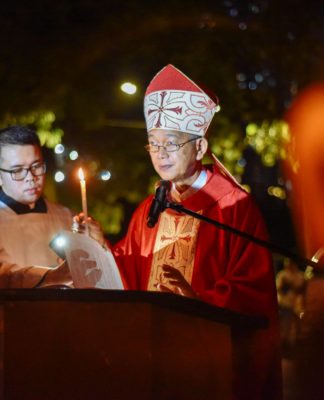 WHAT does it take to be immortalized on top of the Main Building?
WHAT does it take to be immortalized on top of the Main Building?
We often find ourselves looking up to this historic establishment as we pass by, where 15 statues, grouped in threes, are located just below the high cross. Crafted by Italian expatriate sculptor Francesco Monti and installed in the early 1950s, the statues withstood the years and the calamities that passed. But the question that still remains to most Thomasians is: “Who are they?”
The three virtues
At the center of the building is a clock and three statues that flock it. Marked “Tria Haec” or ‘these three’, which pertains to the three virtues of St. Paul (faith, hope, and love), the statues collectively stand as a reminder of what the University stands for.
“The Tria Haec symbolizes our Christian values,” said Augusto de Viana, chairperson of the Department of History.
The University’s tradition of following St. Paul’s theology may be traced to St. Dominic de Guzman, the founder of the Order of Preachers (O.P.).
It was said that St. Dominic had a vision of St. Paul, who handed him a book of his letters, while St. Peter gave him a preacher’s staff. The Tria Haec serves as a reminder to Thomasians about St. Paul’s teaching of “primacy of charity.”
“They (Thomasians) should try to put the message of the Tria Haec into practice,” Fr. Efren Rivera, O.P., associate professor of Scriptures in the Faculty of Sacred Theology, told the Varsitarian in an interview in 2009.
The holy thinkers
To the left of the Tria Haec are statues of three holy men whose ideals helped shape Catholic thinking as it is known today.
Little is known about the personal life of Fr. Vincent de Beauvais, O.P., but the French man made his mark in history as the author of Speculum Majus (Great Mirror), considered to be the greatest encyclopedia of medieval thought. He was successful in the first three installations of his book, which dealt on science, philosophy, art, and history.
He joined the Dominican house in Paris shortly after its founding in 1218, and probably moved to the new Dominican house in his native Beauvais, where he spent the rest of his religious life.
Beside him is St. Augustine, considered to be one of the most important figures in the development of Western Christianity. The theologian who influenced St. Thomas Aquinas was admittedly a deviant of Catholic principles, but eventually sought conversion and became a changed man. His concepts, including “original sin” and “City of God,” are deemed important, and his influence went beyond Catholicism. He served as the bishop of Hippo Regius in Roman Africa.
Another saint who pushed St. Thomas to his endeavors was St. Raymond de Peñafort, O.P., the patron saint of lawyers. A canon lawyer and head of the Dominican order, he was said to be the one who asked St. Thomas to write Summa contra Gentiles, which cites arguments in favor of God and the Christian faith.
The great minds
Placed on the right side of Tria Haec are the statues of three of the best brains in history, whose passion for learning and teaching influenced many.
His name has become a fixture in secondary and tertiary knowledge, but Aristotle is still considered mainly as one of the pillars of Western philosophy.
St. Thomas referred to him as “The Philosopher,” who contributed much to ethics, art, mathematics, and the physical sciences, and is also considered the father of the field of logic.
Another apostle of teaching is St. Albert the Great or Albertus Magnus, who was St. Thomas’ teacher. He was deemed one of the most universal thinkers during the Middle Ages with his field of study going from natural science to theology. Because of this, an auditorium in UST was named after him.
Plato of ancient Greece is one of the most read and studied philosophers of all time. A student of Socrates and the teacher of Aristotle, he is famous for his theory of Forms and for his work, the Republic, a Socratic dialogue which prescribes the characteristics of a just city-state and the nature of justice.
Beautifiers of tragedy
Facing P.Noval Street are three fixtures of men who made their mark in world literature as great writers of tragedy.
Pedro Calderon de la Barca, one of Spain’s most important dramatists, had dominated his country’s Golden Age of Theater. He is best known for his play, Life is a Dream, which explores the conflict between free will and predestination.
At the center is Sophocles, one of the ancient Greek tragedians whose work has survived. An influential writer, he is known for his tragedies on Oedipus and Antigone.
Regarded as the greatest writer in the English language, William Shakespeare wrote 38 plays, 154 sonnets, and two long narrative poems, among others. Some of his most famous works are Romeo and Juliet and Hamlet. His plays have been translated into every major living language and are performed more often than those of any other playwright.
For comedy’s sake
On the opposite side is another set of great writers, whose attack on life had witty impact that would always leave their audience fascinated.
One of them is Lope de Vega, who is one of the prominent fixtures in Spanish literature. A playwright and poet, he is considered to be in the ranks of Miguel de Cervantes, the famous writer who brought Don Quixote de la Mancha into the world.
Cervantes called him “The Phoenix of Wits”.
In ancient Athens, another playwright named Aristophanes made his mark in a genre of comic drama called Old Comedy. His ability to ridicule made him an important and feared man. Also known as the Father of Comedy and the Prince of Ancient Comedy, he has been said to recreate the life of ancient Athens more convincingly than any other author.
Another master of comedy, this time in Western literature, is Jean-Baptiste Poquelin, who was known by his stage name, Moliere. The French playwright and actor was famous for his farces, a type of comedic entertainment that makes use of a speedy plot and exaggerated situations.
Unknowing thoughts
The identity of these statues remains a mystery to some Thomasians, but students acknowledge that they must be placed on a high pedestal for a reason.
“I really don’t know anything about the statues,” Roznelette de los Reyes of the Faculty of Arts and Letters admitted. “But I think they were put up there not just for decoration.”
The Journalism major added that the European-inspired design somehow carries the University’s character.
Meanwhile, Accountancy freshman Tabitha Scudder, who was able to identify Plato, said that the statues must be representations of the higher learning ideals that the University is aiming for.
“I think the statues altogether symbolize royalty and profoundness,” she said. “We are reminded by them to strive harder as students of the royal University.’
For de Viana, the fixtures are very significant for Thomasians.
“Francesco Monti’s creation is historically important,” he said. “The statues are something that Thomasians can look up to for inspiration.” M. R. B. Maranan

















Very good article. :))
Keep up the good work. ;))